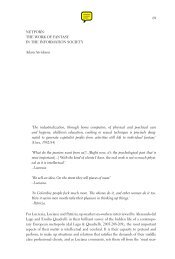Nakamura, Digitizing Race, Introduction, chapter 5, Epilogue
Nakamura, Digitizing Race, Introduction, chapter 5, Epilogue
Nakamura, Digitizing Race, Introduction, chapter 5, Epilogue
Create successful ePaper yourself
Turn your PDF publications into a flip-book with our unique Google optimized e-Paper software.
The Social Optics of <strong>Race</strong> 125<br />
cant, he manipulates the image by orally instructing the computer to “pan<br />
right, magnify, stop,” and so on. Both characters are engaging with the computer<br />
by means other than through a hardware interface: Deckard uses voice<br />
recognition, a technique that hails the computer as an interlocutor, and<br />
Anderton and the Zion gate operator use gesture, a performative and proprioceptive<br />
means of command and control. And in addition, both are engaging<br />
in digital image processing and enhancement as a way to “see” or detect the<br />
truth about a crime. Both Blade Runner and Minority Report begin with extreme<br />
close-up shots of eyes, and as Kaja Silverman writes of Blade Runner:<br />
“However, if the opening shots work in an anticipatory way to break down<br />
the dichotomy between replicants and humans by focusing on an eye which<br />
could represent either, it is because that organ represents precisely the site<br />
at which difference is ostensibly discernible within the world of Blade Runner.”<br />
53 Minority Report’s ubiquitous shots of eyes being scanned in shopping<br />
malls, subways, housing projects, and workplaces expands this notion of<br />
retinal surveillance to the public sphere in its entirety. The eye becomes the<br />
sole signifier of identity in this panoptic future. Hence the positioning of<br />
Anderton’s eye as an Asian one allows the notion of hybrid forms of subjectivity<br />
to come into play. Far from the celebratory mestiza subject of Gloria<br />
Anzaldúa’s writings, however, this one comes from a lack of empathy rather<br />
than a plurality of it—Anderton only needs to take the position of the<br />
raced, hunted, marginalized person of color into account, he only needs to<br />
really see it, at the moment that he begins his new life as a fugitive from justice.<br />
Hence cyberculture enables a privileged view of image and race as<br />
code and takes it away: the same computers that allow Anderton to “scrub”<br />
the image make him permanently vulnerable to their surveillance. This unprecedented<br />
vulnerability to techno-surveillance is, however, part of what it<br />
means to be a person of color in the “integrated circuit,” to use Haraway’s<br />
eloquent formulation. Donna Haraway and Paul Gilroy both strongly insist<br />
on the revisioning of race as code, genome, and restlessly interrogate this system:<br />
the visuality of race has retreated from pencil tests, paper bag tests, and<br />
other naked-eye optical assessments and now resides in acronyms like ART,<br />
DNA, IVF, and HGP. 54 The primacy of vision reigns unchallenged but only<br />
on a level so microscopic that only machines can “see” it. Advances in<br />
biotechnology extend a process of visualizing the body as information that<br />
began in the mid-twentieth century. In Sarah Chinn’s fascinating history of<br />
the Red Cross and its policies regarding cross-racial blood donation during<br />
World War II and before, she remarks that blood replaced skin as the ruling





